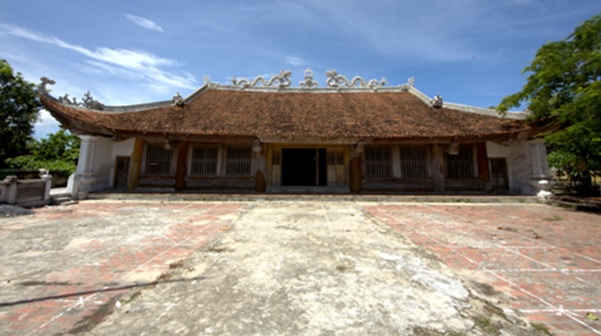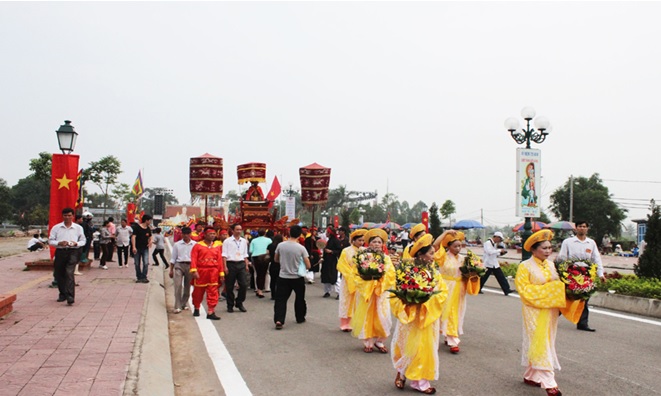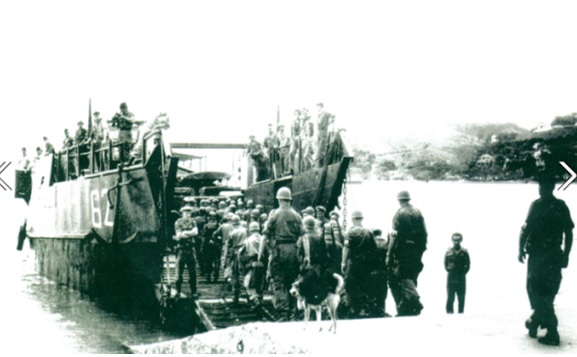Cultural - Historical values
Ha Long Area is one of the Homes to the Ancient Viet people.
According to archeological researches, the earliest vestiges of people’ life in Ha Long Bay was remained from owner of Soi Nhu culture. The next is Cai Beo culture owner with the first contact with the sea. The last owner belonged to Ha Long culture. Ha Long culture played a very important role in the ancient Vietnamese civilization, marking a exposure of the ancient Viet people with the marine economy, creating a unique sea -related -culture in Vietnam.
Soi Nhụ Culture (about 18,000 to 7,000 years ago): People in this period
of time mainly lived in limestone islands in Ha Long Bay, Bai Tu Long Bay, and coastal caves. Their method of earning for food were hunting, picking fruits and catching freshwater molluscs. They used stone tools made with simple technique that is tightening, chopping almost no mending.

The archaeological site of Soi Nhu cave, which was found traces of ancient Vietnamese 14,000 years ago

Archaeological sites of Tien Ong cave
Cai Beo Culture:(About 7000 - 5000 years ago). Residents of this culture mainly resided on the shore of closed bay, leaning against stone mountains. The height of relics of this culture is 2-6m above present sea level. Their method of earning for food was is primarily coastal fishing, and then combined with traditional methods, such as hunting wild animals, collecting natural legumes and fruits. Tools used were simple, mainly sharp tools. The hedge technique is mainly on one side and can be used to flatten the distractions on the opposite side to create a fringe of ringe. Cai Beo pottery was rough, thick, heavy and simple type at the begining period. The later stage is smooth ceramic, the cord, and diverse in type. Porous ceramic began to appear in small numbers demonstrateing the rapid development of prehistoric people.

Di chỉ khảo cổ Cái Bèo
Ha Long Culture: (4500 to 3500 years ago) is divided into early and late stages.
EarlyStage was the result of middle-Holocene marine transgression in the period 6,000 to 5,000 years ago. This caused the loss of a living environment of the Cai Beo people. Therefore, most of them had to move to the northeast area and higher regions. Since then, the earlier Ha Long culture was formed. In this stage, people earned for food mainly by hunting, picking fruits, farming, planting fiber crops, fruits and vegetables, and increasing fishing.
Later Stage:this stage came as the result of the period of maximum marine transgression and regression. This culture developed with the migration of Ha Long people into the plains, midlands and mountainous areas. The Ha Long people’s habitats were relatively diverse including caves, mountain peaks and sand bars. Working tools were unique and mainly made from limestone by high-level manufacturing techniques. Pottery handicrafts were developed with the use of potter's wheel and decorative pattern of its products were mainly the rope, the relief stripes, the carved lines, the base. The pottery products with diverse decorative pattern were typical characteristics of Ha Long culture.

Di chỉ khảo cổ hang Trinh nữ
Hiện nay, trên vịnh Hạ Long có một số hang động đang lưu giữ các vết tích văn hóa của người tiền sử như là: hang Tiên Ông, hang Trống, hang Trinh Nữ, hang Bồ Nâu, động Mê Cung, động Thiên Long …Ngoài ra, hang Tiên Ông đang lưu giữ, bảo tồn những hố thám sát, hố khai quật khảo cổ với những trầm tích là vỏ ốc suối (Melania), ốc núi (Cyclophorus), là một trong những bằng chứng sinh động về phương thức cư trú, sinh sống trong hang động của người tiền sử Hạ Long thuộc văn hóa Soi Nhụ.
Khu vực vịnh Hạ Long là nơi ghi dấu lịch sử dựng nước và giữ nước của dân tộc trong các thời đại quân chủ Phong kiến
Với vị trí chiến lược quan trọng, ngay từ thế kỷ XII (năm 1149) dưới triều vua Lý Anh Tông, trong khu vực vịnh Hạ Long, thương cảng Vân Đồn đã được thành lập. Đây không chỉ là một bến cảng mà là một hệ thống gồm nhiều bến thuyền thương mại trên các đảo quây quần trên vùng vịnh Bái Tử Long. Ngày nay những dấu tích về những bến thuyền cổ còn tìm thấy khá dày đặc, phong phú tại các khu vực đảo Cống Đông, Cống Tây, Vân Hải, Quan Lạn…Hàng vạn mảnh gốm sứ đặc trưng cho các thời kỳ Lý, Trần, Lê, Mạc cùng nhiều hiện vật có giá trị lịch sử, văn hóa, nghệ thuật . Bên cạnh những dấu tích đồ sộ của các thuyền cổ ngày nay chúng ta còn phát hiện nhiều dấu tích của các công trình văn hóa như : đình, chùa, đền, miếu, tháp: chùa Lấm, chùa Trong, chùa Cát và cụm di tích đình, đền, chùa Quan Lạn.

Bức tranh thương cảng cổ lưu giữ tại Bảo tàng Quảng Ninh

Vân Đồn ngày nay

Đình Quan Lạn tại đảo Quan Lạn, Huyện Vân Đồn
Trong lịch sử dựng nước và giữ nước của dân tộc Việt Nam, vịnh Hạ Long còn là nơi ghi dấu những chiến công hào hùng của dân tộc từ thế kỷ X đến thế kỷ XX, đó là: Ngô Quyền đánh thắng quân Nam Hán (năm 938), Lê Hoàn đánh thắng quân Tống (năm 981), Trần Hưng Đạo đánh thắng quân Nguyên Mông (năm 1288). Hiện nay, khu vực vịnh Hạ Long còn có nhiều di tích lịch sử và di chỉ văn hoá như: Đình Quan Lạn, chùa Lấm, đền Bà Men... Đặc biệt người dân vùng biển Hạ Long vẫn lưu giữ được những nét văn hoá truyền thống độc đáo, phong phú từ bao đời. Nó được thể hiện qua những câu ca dao, tục ngữ, lễ hội, kinh nghiệm, phản ánh tâm tư, tình cảm được truyền từ đời này qua đời khác.

Rước tượng Đức thánh Trần trong lễ hội Bạch Đằng tại TX Quảng Yên

Lễ hội đền Đức Ông Trần Quốc Nghiễn

Lễ hội đền Bà Men
The area of Ha Long Bay is a Place where maintaining the History of National Construction and National defense in the Pre-modern, Modern History
During the war against the French:
+ Duc Tien Cave: Vestige of a militant group under the leading of De Hong anh Cai Thai to fight against the French colony. The cave located on the southeast of Van Gio island (376 island on the map, folk name is Cánh Quít Mountain). At that time, the militant group produce weapon and coins for the war against the French.
+ On May 1, 1930, a red flag with a hammer flied on the top of Bai Tho mountain, marking a new stage of revolution of labor organization in Quang Ninh mining area in the purpose of being free of French colonial domination.
+ On March 24, 1946, President Ho Chi Minh met with French High Commissioner D’Argenlieu on board Esmille Bertinon Ha Long Bay.

Đúc Tiền cave

Quân Pháp rút khỏi khu mỏ tại Bến Phà Bãi Cháy ngày 24/4/1955
During the War Against the The United States of America
+ In the early 1960s, non-haul ships departed Ha Long area for Southern Vietnam carrying weapons, ammunition contributing to the glorious victory of Vietnam in the war against the United States of America (Ho Chi Minh Sea Route).
+ Ha Long Bay witnessed the first air strike and failure of the United States Air Force when they first launched a war to destroy the North of Vietnam on August 5, 1964. At this time the first American pilot Everett Alvarez .

Phân đội tàu trong chiến thắng đầu tiên của Hải quân Nhân dân Việt Nam
Phòng Ngiệp vụ Nghiên cứu
